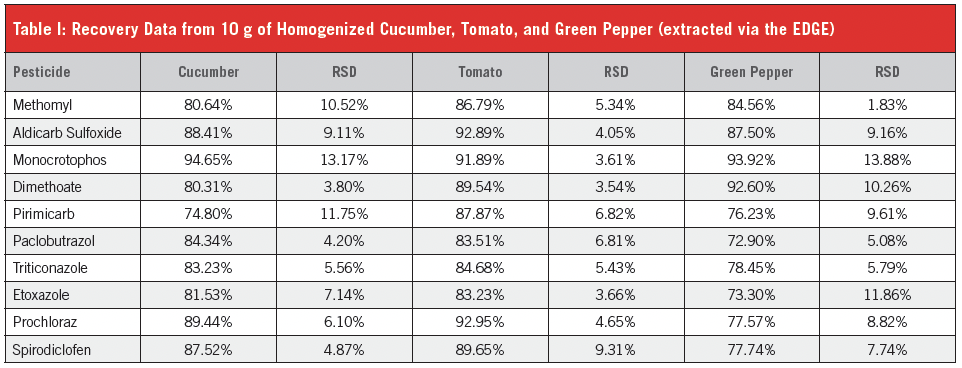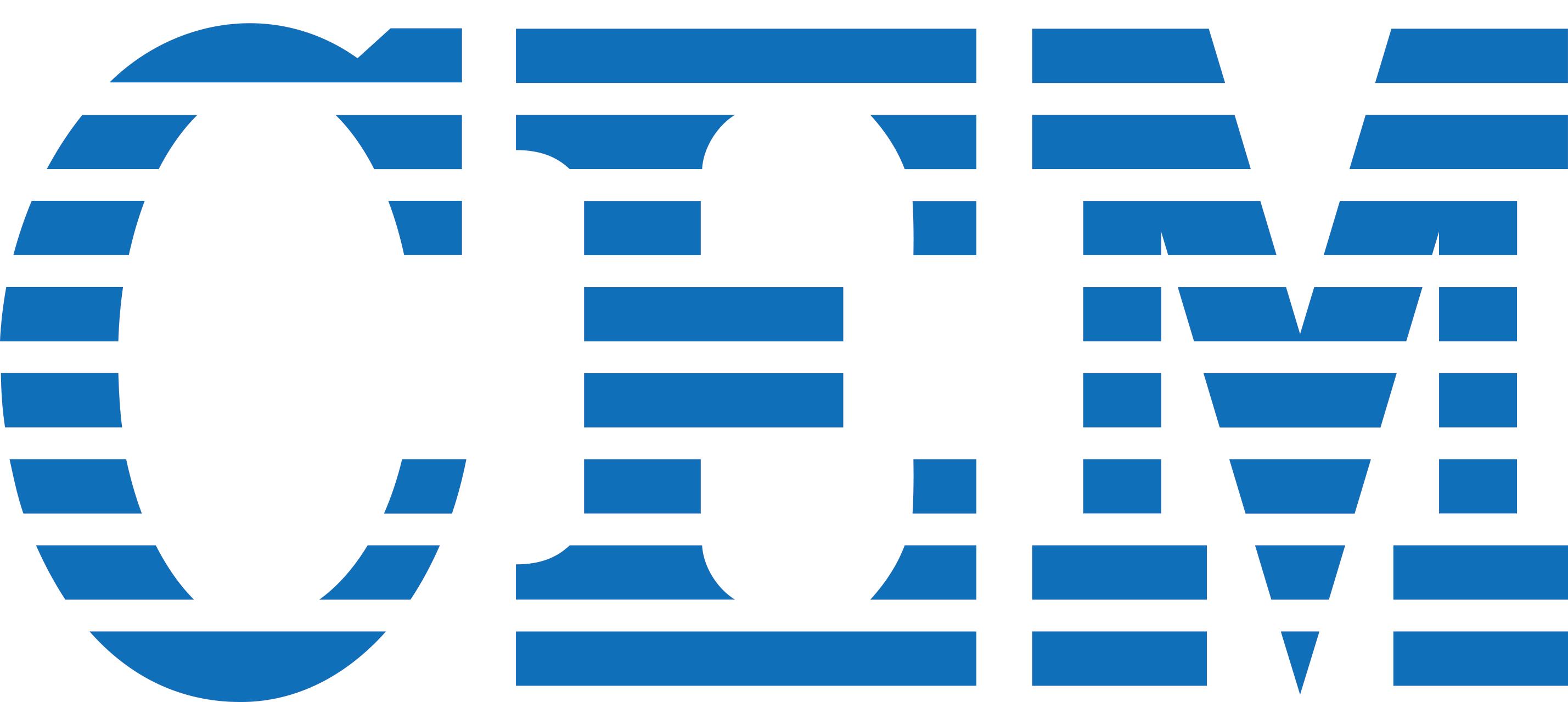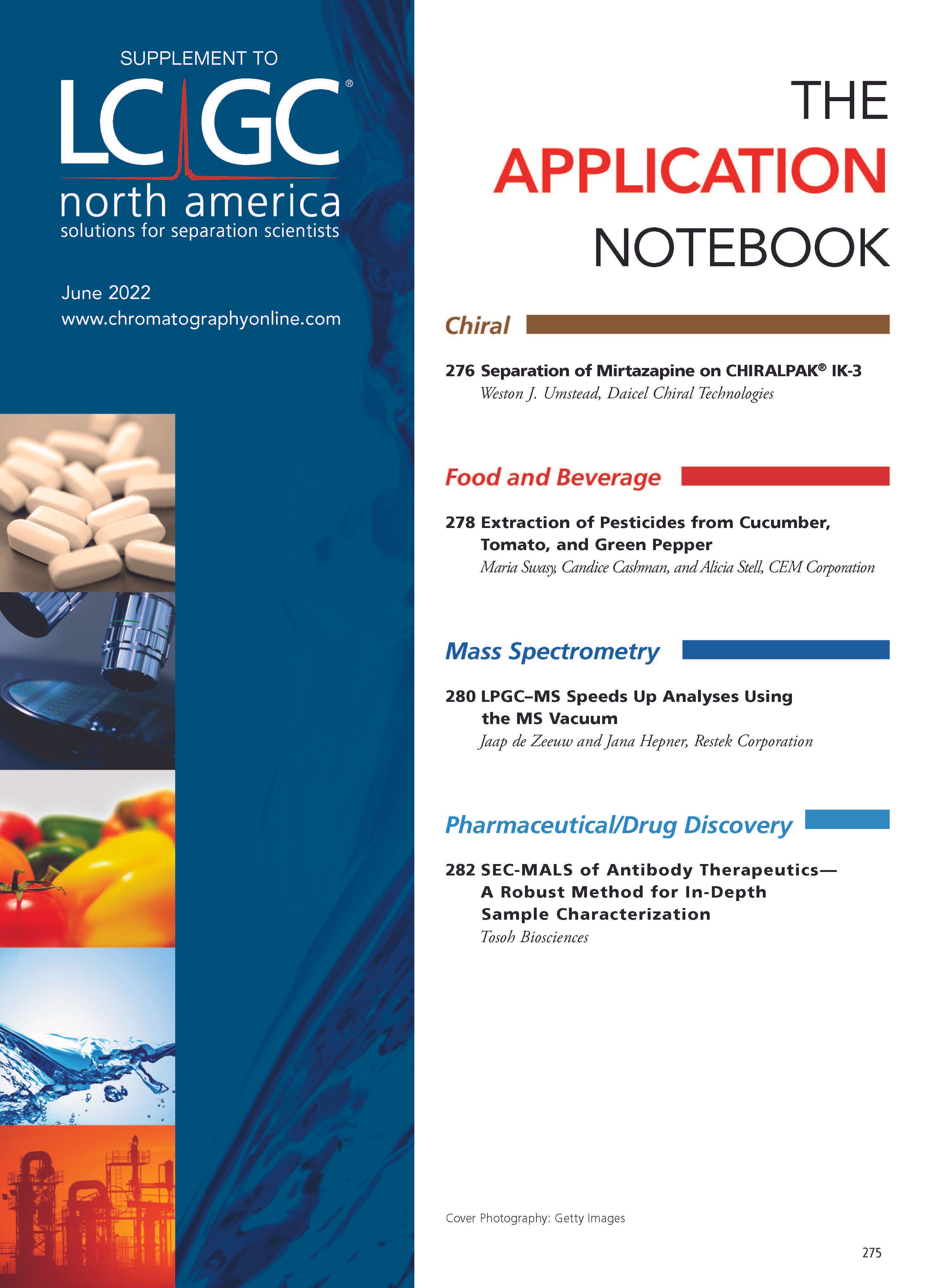Extraction of Pesticides from Cucumber, Tomato, and Green Pepper
Pesticide testing is crucial to assessing the safety of fruits and vegetables for consumption. The traditional extraction method for pesticides from produce is the QuEChERS method. This method is tedious, manual, time consuming, and wasteful. Thus, there is a need for improved methods of extraction. In this application note, the EDGE®, in combination with Q-Matrix™ Hydra, a water-removing sorbent, was used to extract a panel of pesticides from 10 g of homogenized cucumber, tomato, and green pepper in less than 9 min. The recoveries of the pesticide panel were greater than 70% for each matrix tested, and these results were highly reproducible. The EDGE provides a fully automated extraction that combines both the sample and sorbent into one sample vessel, alleviating the human burden of extraction and the need for multiple sample transfers.
Introduction
When shopping for produce, consumers want to know that their vegetables and fruits are free of toxic levels of harmful compounds, such as pesticides. Pesticide testing is important because they are known to be harmful to humans and wildlife at certain concentrations. Currently, the industry standard method used to extract the pesticides from fruits and vegetables is the QuEChERS method. This method of extraction requires the tedious weighing of salts, imprecise manual shaking, and multiple sample transfers, which are all time consuming.Ultimately, one extraction takes between 20 and 60 min to complete. Also, the multi-step transfers generate substantial waste. Because of these pain points, food manufacturers have desired an improved method that is faster and automated with the same high recoveries and reproducibility.
In this application note, the EDGE extracted a panel of pesticides from 10 g of homogenized cucumber, tomato, and green pepper using a new bubbling feature and Q-Matrix Hydra, a water-removing sorbent, in less than 9 min. The EDGE simplifies the extraction process by using Q-Cup® technology, which contains both the sample and Q-Matrix Hydra in one sample cell, thus alleviating the need for multiple transfers and the generation of waste. Also, the EDGE utilizes its automated bubbling feature to obtain thorough sample mixing, while relieving the human burden of manual shaking. The recoveries of each pesticide were greater than 70% with RSD values less than 15%, indicating a thorough extraction with great reproducibility.
Materials and Methods
Reagents
Cucumbers, tomatoes, and green peppers were purchased from a local grocery store. Q-Matrix Hydra is a product of CEM Corporation.
ACS Grade acetonitrile and acetic acid were purchased from Sigma-Aldrich. A custom mix containing 1000 µg/ ml of methomyl, aldicarb sulfoxide, monocrotophos, dimethoate, pirimicarb, paclobutrazol, triticonazole, etoxazole, prochloraz, and spirodiclofen in acetonitrile was purchased from SPEX CertiPrep.
Sample Preparation
The fruits and vegetables were homogenized using a Magic Bullet blender. A Q-Cup was assembled to contain the S1 Q-Disc® stack (C9 + G1+ C9 sandwich). A portion of 2.5 g of Q-Matrix Hydra was weighed in a Q-Cup, and 10 g of homogenized fruit/vegetable was layered on top of the sorbent. The sample was spiked with 500 ng of the custom pesticide mix. The Q-Cups were placed in a rack, along with 50 mL polypropylene conical tubes, and extracted on the EDGE using acetonitrile w/ 1.0% acetic acid (v/v). Each vegetable and fruit homogenate was extracted in triplicate. Each extract was evaporated down to 5 mL.
EDGE Method for Pesticides in Wet Foods
Q-Disc: S1 Q-Disc stack (C9 + G1+ C9 sandwich)
Cycle 1
Extraction Solvent: acetonitrile w/ 1.0% acetic acid (v/v)
Agitation: 02:00 (mm:ss)
Top Add: 15 mL
Bottom Add: 10 mL
Rinse: 5 mL
Temperature: 40 °C
Hold Time: 01:00 (mm:ss)
Cycle 2 (Rinse Only)
Extraction Solvent: acetonitrile w/ 1.0% acetic acid (v/v)
Top Add: 0 mL
Bottom Add: 0 mL
Rinse: 10 mL
Temperature: - - -
Hold Time: - -:- -
Wash 1
Wash Solvent: acetonitrile w/ 1.0% acetic acid (v/v)
Wash Volume: 15 mL
Temperature: 40 °C
Hold: 0:15 (mm:ss)
Analysis
A volume of 2 µL of each evaporated extract was injected onto a Restek ARC-18 column (2.7 μm, 100 x 2.1 mm) and separated using a Waters Acquity UPLC. The UPLC program utilized a gradient of A: water containing 10 mM ammonium acetate with 0.2% formic acid and B: methanol containing 10 mM ammonium acetate with 0.2% formic acid. The gradient was over 7 min and started at 95% A and ended at 100% B. The MRM transitions for each pesticide were monitored using an attached Xevo TQD mass spectrometer.
Results
Table I shows the recoveries for the pesticide mix from cucumber, tomato, and green pepper. The EDGE efficiently extracted the pesticides in less than 9 min, including cooling, filtering, and system washing. The pesticide recoveries obtained were greater than 70% for all matrices, and the relative standard deviations were below 15%, indicating excellent recoveries and reproducibility, in only one simple step. Thus, the EDGE is an efficient, rapid, and automated alternative to the QuEChERS method.

Conclusion
The EDGE rapidly extracted the pesticides from 10 g samples of homogenized cucumber, tomato, and green pepper using a new bubbling feature and Q-Matrix Hydra. Recoveries greater than 70% with excellent reproducibility (RSDs less than 15%) were achieved. The EDGE improves upon several pitfalls of the QuEChERS method, such as waste generation and multiple sample transfers, by utilizing Q-Cup Technology and automation. Based on the variety of matrices tested here, the method described here is likely applicable to other fruits and vegetables. The EDGE is the ideal choice for food testing laboratories that want to automate their pesticide extraction method.

CEM Corporation
3100 Smith Farm Road, Matthews, NC 28104
Tel. (800) 726-3331
Website: www.cem.com
Analytical Challenges in Measuring Migration from Food Contact Materials
November 2nd 2015Food contact materials contain low molecular weight additives and processing aids which can migrate into foods leading to trace levels of contamination. Food safety is ensured through regulations, comprising compositional controls and migration limits, which present a significant analytical challenge to the food industry to ensure compliance and demonstrate due diligence. Of the various analytical approaches, LC-MS/MS has proved to be an essential tool in monitoring migration of target compounds into foods, and more sophisticated approaches such as LC-high resolution MS (Orbitrap) are being increasingly used for untargeted analysis to monitor non-intentionally added substances. This podcast will provide an overview to this area, illustrated with various applications showing current approaches being employed.




